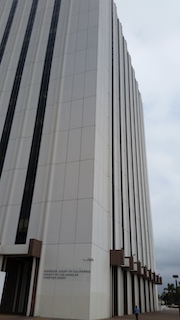Award Recipient
Top 100 Trial Attorneys in the United States
Contact Us for a Free ConsultationWhat One Should Learn from This Article: While each case has different facts, different law that applies and different issues, the preliminary hearing is one common gate that each felony case must pass through prior to the matter being set for trial. This gate is a good point at which to ask the judge to rule on certain issues. This article lays out some of the more common things a judge can decide at this point.
 Compton Courthouse
Compton Courthouse1. Motion for Discovery and for Sanctions or to Dismiss based on the prosecution’s destruction of loss of evidence. This motion should be supported by documentation that shows defendant timely requested such information under Penal Code § 1054.1 and asked the prosecution to produce it and preserve it. The statutory authority for such a motion is Arizona v. Youngblood (1988) 488 U.S. 51, 102 L. Ed. 2d 281, 109 S. Ct. 333 and California v. Trombetta (1984) 467 U.S. 479, 81 L. Ed. 2d 413, 104 S. Ct. 2528;For more information about preliminary hearings, please click on the following articles:
2. Motions to Preserve and Obtain Video and Audio Recordings made of communications by the arresting officers concerning defendant’s arrest. This may show racial profiling, pretextual conduct or support a motion to suppress. Under Government Code § 26202.6, recordings need only be preserved for 100 days after arrest without a request otherwise. See also People v. Madden (1970) 2 Cal. 3d 1017, 88 Cal. Rptr. 171; People v. Armstrong (1991) 232 Cal.App.3d 228, 241, 283 Cal.Rptr. 429.
3. Motion to Discover Prior Acts of Violence by the Victim in a Self-Defense Case. Engstrom v. Superior Court (1971) 20 Cal.App.3d 240, 97 Cal.Rptr. 484. The documents sought could establish the reasonableness of defendant’s force and scope of force used.
4. Motion to Discover Information to Support a Motion to Dismiss based on Discriminatory Enforcement of the Law. This is a so-called “Murgia motion.” Murgia v. Municipal Court (1975) 15 Cal.3d 286, 124 Cal.Rptr. 204.
5. Motion to Discover a Police Office’s Prior Use of Excessive Force or Bias. This is a “Pitchess motion” named after former Los Angeles County Sheriff Pete Pitchess, who served before Sherman Block and Lee Baca. Pitchess v. Superior Court (1974) 11 Cal.3d 531, 113 Cal. Rptr. 897.
6. Motion to Disclose the Identity of an Informant. Cooper v. Superior Court (1981) 118 Cal.App. 3d 499, 173 Cal.Rptr. 520.
7. Motion to Challenge the Method of Defense Identification, i.e. for a line up. People v. Green (1979) 95 Cal.App.3d 991, 157 Cal.Rptr. 520; People v. Malich (1971) 15 Cal.App. 3d 253, 93 Cal. Rptr. 87.
8. Application to Videotape the Preliminary Hearing. This motion must be noticed in writing three days prior to the preliminary hearing. Penal Code § 1346(b).
9. Motion to Continue the Preliminary Hearing. Penal Code § 1050. This motion is often done if there is new evidence that becomes available for review before the preliminary hearing or new witnesses that are identified who must be interviewed prior to the preliminary hearing.
10. Motion to Reclassify the Felony Charge(s) as Misdemeanor Charge(s). Penal Code § 17(b)(5). This is perhaps the most common motion filed that has the most effect over the case if granted.
Contact us.